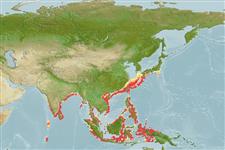Common names from other countries
Environment: milieu / climate zone / depth range / distribution range
Écologie
; profondeur 72 - 180 m (Ref. 4), usually 72 - 84 m (Ref. 4). Tropical; 36°N - 8°S, 72°E - 141°E (Ref. 4)
Distribution
Pays | Zones FAO | Écosystèmes | Occurrences | Introductions
Indo-West Pacific.
Length at first maturity / Taille / Poids / Âge
Maturity: Lm 9.6, range 9 - ? cm Max length : 14.0 cm TL mâle / non sexé; (Ref. 122082); common length : 10.0 cm TL mâle / non sexé; (Ref. 4)
It has lengths of 5 to 10 cm, total body length; 0.8 to 3.2 cm, carapace length. (Ref. 4).
Life cycle and mating behavior
Maturité | Reproduction | Frai | Œufs | Fécondité | Larves
Members of the order Decapoda are mostly gonochoric. Mating behavior: Precopulatory courtship ritual is common (through olfactory and tactile cues); usually indirect sperm transfer.
Sekiguchi, N. and S. Okubo. 1986. (Ref. 191)
Statut dans la liste rouge de l'IUCN (Ref. 130435: Version 2024-1)
statut CITES (Ref. 108899)
Not Evaluated
Not Evaluated
Utilisations par l'homme
Pêcheries: d'intérêt potentiel
| FishSource |
Outils
Sources Internet
Estimates based on models
Preferred temperature
(Ref.
115969): 23.8 - 27.5, mean 25.8 (based on 49 cells).
Vulnérabilité
Low vulnerability (10 of 100).
